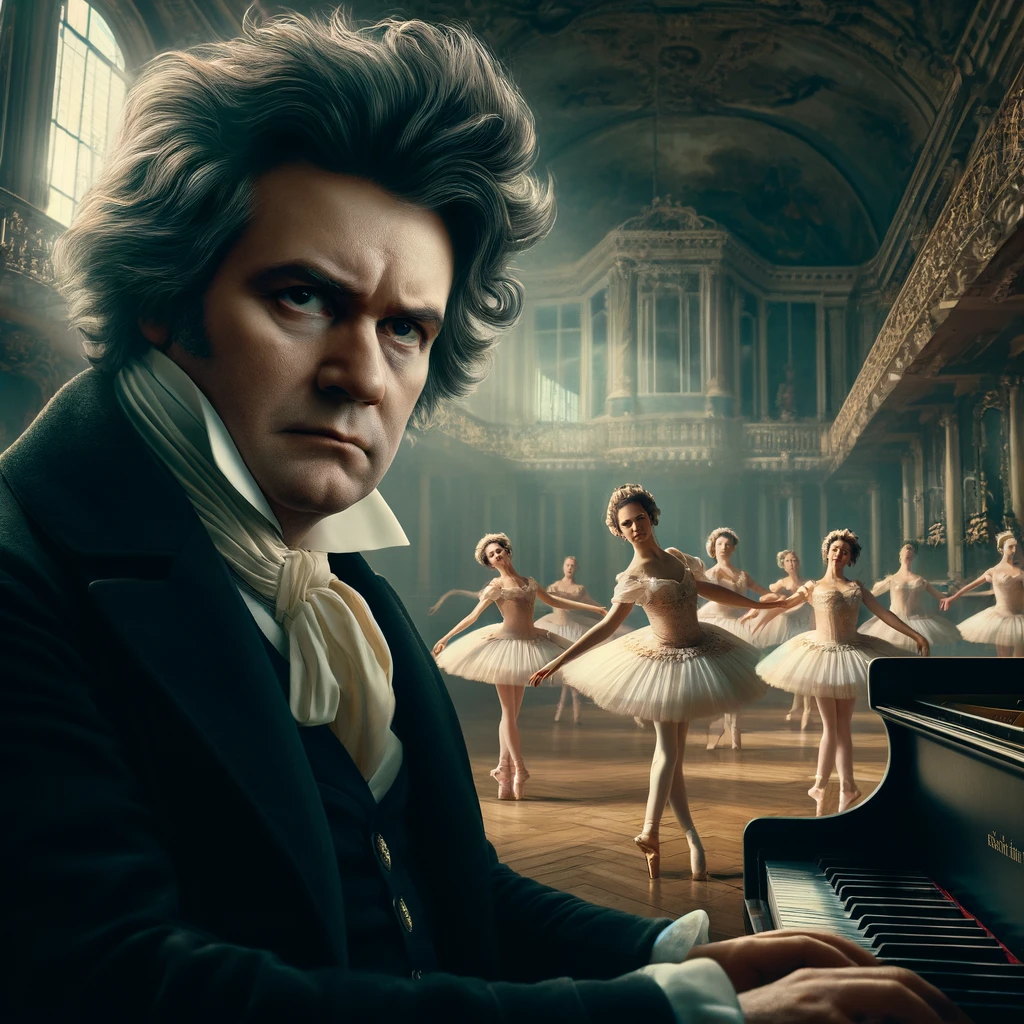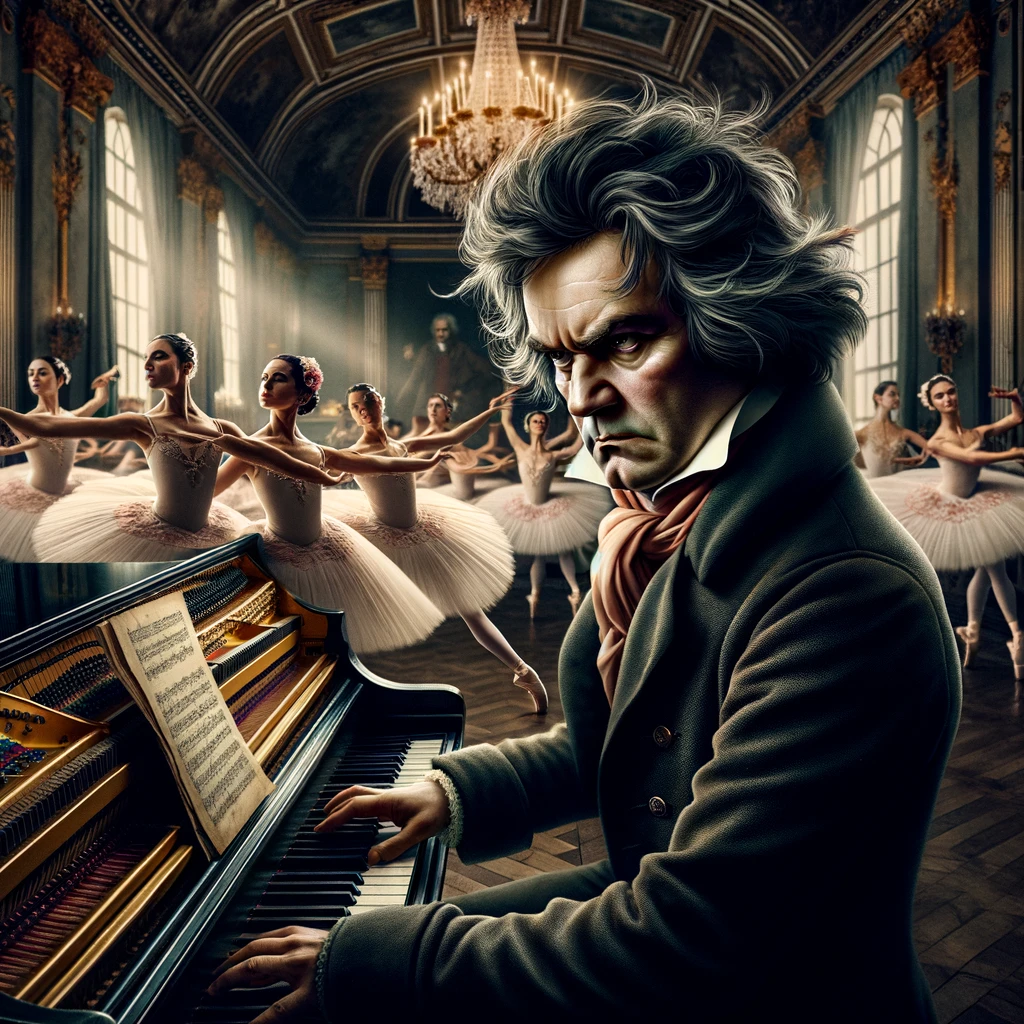
Beethoven and Ballet: His Music in Dance
Ludwig van Beethoven, a titan of classical music, has left an indelible mark not only on music but on the broader canvas of the arts, influencing numerous fields including the world of ballet. Despite being known primarily for his symphonies, sonatas, and quartets, Beethoven’s work has also found a unique niche in ballet, an art form that traditionally leans towards composers like Tchaikovsky or Stravinsky. The exploration of his influence in ballet unveils a fascinating blend of robust symphonies and delicate choreographic interpretations.
The Challenge of Choreographing to Beethoven
Choreographing ballet to Beethoven’s music presents unique challenges. Unlike many composers whose works are frequently adapted to ballet, Beethoven’s compositions weren’t originally intended for dance. His music, characterized by dramatic changes in tempo and dynamic shifts, poses a complex task for choreographers who seek to synchronize movements that embody the music’s power and emotional depth.
Historically, ballet has gravitated towards compositions specifically crafted to complement the fluid and narrative style of dance, such as those by Tchaikovsky in “Swan Lake” or Prokofiev in “Romeo and Juliet.” These pieces often provide a rhythmic consistency and melodic expressiveness that naturally lend themselves to dance. In contrast, Beethoven’s pieces, with their intricate structures and sudden outbursts, require choreographers to creatively interpret and sometimes even re-imagine the music to fit a balletic framework.
Pioneering Works
The adaptation of Beethoven’s music for ballet has seen various interpretations, each reflecting the choreographer’s unique vision. One of the earliest and most notable attempts was by the legendary choreographer George Balanchine. In 1952, Balanchine choreographed “Concerto Barocco” to Beethoven’s “Violin Concerto in D Major.” This ballet is a striking example of abstract ballet where the music dictates the structure rather than a narrative guiding the choreography.
Another groundbreaking work is Maurice Béjart’s “Ninth Symphony,” choreographed in 1964 to Beethoven’s symphony of the same name. Béjart’s interpretation is a powerful, large-scale production that combines classical ballet elements with modern dance, reflecting the universality and revolutionary spirit of Beethoven’s music. This ballet not only highlights the choreographic flexibility required to adapt Beethoven’s symphonic work but also demonstrates the potential of his music to convey profound philosophical themes.
Modern Interpretations
In more recent years, choreographers have continued to explore Beethoven’s music through ballet. John Neumeier’s “Beethoven Project” illustrates an innovative approach to marrying classical music with contemporary ballet, creating a dialogue between the music and modern-day issues. His work showcases how Beethoven’s themes of struggle and triumph resonate with contemporary audiences, providing a rich tapestry for ballet’s expressive potential.
Similarly, the use of Beethoven’s “String Quartet No. 15” in “Opus 131,” choreographed by Alexei Ratmansky, emphasizes the emotional and introspective qualities of Beethoven’s late quartets. Ratmansky’s choreography delves deep into the introspective and sometimes melancholic atmosphere of the music, offering a stark contrast to the often vibrant and narrative-driven ballets set to more traditional “dance” scores.
Educational Impact
Beyond performance, Beethoven’s music has played a significant role in dance education, where his compositions are frequently used as accompaniment for ballet classes and exercises. This practice has introduced countless dancers to the complexities of his music, allowing them to develop an appreciation for its structure and dynamics. This educational aspect underscores the adaptability of Beethoven’s music, demonstrating its capacity to enhance a dancer’s rhythm, musicality, and expressiveness.
The choreographing of ballet to Beethoven’s music is a testament to the composer’s enduring influence across artistic disciplines. Despite the inherent challenges, ballet has embraced his works, translating the complexities of his music into the language of dance. This cross-disciplinary encounter enriches both the music and the dance, offering audiences new ways to experience and interpret Beethoven’s legacy. As ballet continues to evolve, the innovative and bold interpretations of Beethoven’s compositions are likely to inspire and challenge future generations of choreographers and dancers, cementing his place not just in the annals of music history but also within the dynamic world of ballet.

Beethoven’s Music: A Catalyst for Choreographic Innovation
The synergy between Beethoven’s music and ballet extends beyond the stage into the realm of choreographic innovation. His music, with its intense emotional depth and complex structures, challenges choreographers to push the boundaries of traditional ballet aesthetics and create something entirely new. This innovation is evident not only in full-scale ballets but also in smaller, more experimental pieces that explore the nuances of his compositions.
The Role of Music Interpretation in Ballet
Interpreting Beethoven’s music for ballet involves more than matching dance steps to musical notes; it requires a deep understanding of the emotional and thematic content of his work. Choreographers must delve into the narrative Beethoven constructs through his musical phrasing and motifs to reflect the same intensity and drama in their choreography. This interpretative process is crucial in transforming the music from a mere auditory experience to a visual and kinesthetic spectacle that captivates ballet audiences.
Collaboration and Multidisciplinary Approaches
The adaptation of Beethoven’s music in ballet also highlights the importance of collaboration between musicians, choreographers, and dancers. These collaborations often result in multidisciplinary performances that not only showcase Beethoven’s music but also bring out new dimensions in each discipline. For instance, incorporating live orchestral performances with ballet introduces a dynamic interaction where musicians and dancers respond to each other in real-time, enhancing the overall impact of the performance.
Global Reach and Cultural Impact
Beethoven’s influence on ballet has not been confined to Western countries but has permeated cultures around the world. Companies across Europe, Asia, and the Americas have incorporated his music into their repertoires, demonstrating its universal appeal and adaptability. This global embrace not only enriches the international ballet scene but also ensures that Beethoven’s legacy continues to inspire across cultural boundaries.
The cultural impact of Beethoven’s music in ballet is also evident in how it has been used to comment on social and political themes. Choreographers have often utilized his music to convey messages of resistance, freedom, and human dignity, themes that are deeply embedded in Beethoven’s own life and work. This thematic resonance makes Beethoven’s music a powerful tool for ballet companies to engage with contemporary issues while maintaining artistic and musical integrity.
Technological Advances and New Media
The advent of new media and technology offers further opportunities to explore Beethoven’s music through ballet. Digital platforms and virtual reality have opened new avenues for experiencing ballet, allowing audiences to engage with Beethoven’s music and its choreographic interpretations in innovative ways. These technologies not only broaden the audience base but also provide a fresh perspective on how ballet can be choreographed, performed, and perceived in the digital age.
The Future of Beethoven in Ballet
As we look to the future, the relationship between Beethoven’s music and ballet promises to remain vibrant and evolving. Emerging choreographers continue to draw inspiration from his works, finding new ways to interpret and stage his music. With each adaptation, they contribute to a rich dialogue between music and dance, highlighting the timeless quality of Beethoven’s compositions and their endless potential for reinterpretation.
Conclusion
Beethoven’s foray into the world of ballet may not have been a deliberate one, but his music has undoubtedly found a home in this art form. Through the challenges and innovations it inspires, Beethoven’s music continues to enrich the world of ballet, bridging the gap between classical composition and contemporary dance. The choreographic interpretations of his work not only honor his musical genius but also ensure that his influence remains vibrant and relevant in the ever-evolving landscape of the arts. As ballet and music continue to intersect, Beethoven’s legacy will undoubtedly continue to inspire, challenge, and move the hearts of audiences around the globe.